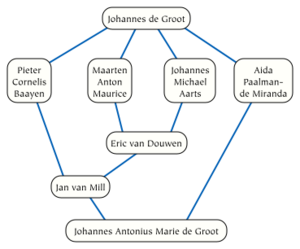Academic genealogy facts for kids

Imagine a special kind of family tree for scientists and thinkers! An academic genealogy (say: ah-ka-DEM-ik jee-nee-AL-uh-jee) shows how teachers and students are connected. Instead of family members, it tracks who taught whom, especially through university advisors. It's like a 'knowledge family tree' where ideas are passed down.
Understanding Academic Family Trees
The academic lineage or academic ancestry of a person is a chain of professors. These professors have been mentors or thesis advisors to each other. This chain ends with the person you are looking at. Many terms from regular genealogy are used here too. You might hear about academic descendants, children, or siblings.
One way to create an academic genealogy is to list people by how closely they worked with a mentor. This usually means:
- Doctoral students (who get a PhD)
- Post-doctoral researchers (who do research after their PhD)
- Master's students (who get a Master's degree)
- Current students, including those doing research as undergraduates
A Look at History
In the 1800s, especially for scientists like chemists, it was common to study medicine or pharmacy first. Then, they would continue with advanced studies. Until the early 1900s, you didn't always need a doctorate to become a professor. For example, the University of Cambridge in England didn't require a formal PhD paper until 1919. So, older academic family trees for Cambridge students might just show who their main teacher was.
It's quite easy to research academic genealogies in Spain. Until 1954, only one university, Complutense University, could give out doctorate degrees. This means that almost everyone with a doctorate in Spain can trace their academic family tree back to a professor at Complutense.
Where to Find Academic Family Trees
There are special websites that keep track of these academic connections. For example, the Mathematics Genealogy Project lists academic family trees for mathematicians. The Chemical Genealogy does the same for chemists. Other sites, like Neurotree and Academic Family Tree, try to connect scholars from all different subjects. They show how knowledge and ideas have spread through generations of teachers and students.

